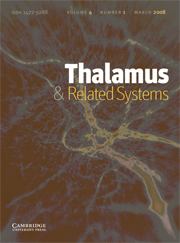No CrossRef data available.
Article contents
Variability of quantal synaptic currents in thalamocortical neurons
Published online by Cambridge University Press: 18 April 2006
Abstract
Broad amplitude variability and skewed distributions are characteristic features of quantal synaptic currents (minis) at central synapses. The relative contributions of the various underlying sources are still debated. Through computational models of thalamocortical neurons, we separated intra- from extra-synaptic sources. Our simulations indicate that the external factors of local input resistance and dendritic filtering generate equally small amounts of negatively skewed synaptic variability. The ability of these two factors to reduce positive skew increased as their contribution to variability increased, which in control trials for morphological, biophysical, and experimental parameters never exceeded 10% of the range. With these dendritic factors ruled out, we tested multiple release models, which led to distributions with clearly non-physiological multiple peaks. We conclude that intra-synaptic organization is the primary determinant of synaptic variability in thalamocortical neurons and, due to extra-synaptic mechanisms, is more potent than the data suggested. Thalamortical neurons, especially in rodents, constitute a remarkably favorable system for molecular genetic studies of synaptic variability and its functional consequence.
Information
- Type
- Research Article
- Information
- Copyright
- Elsevier Science Ltd

